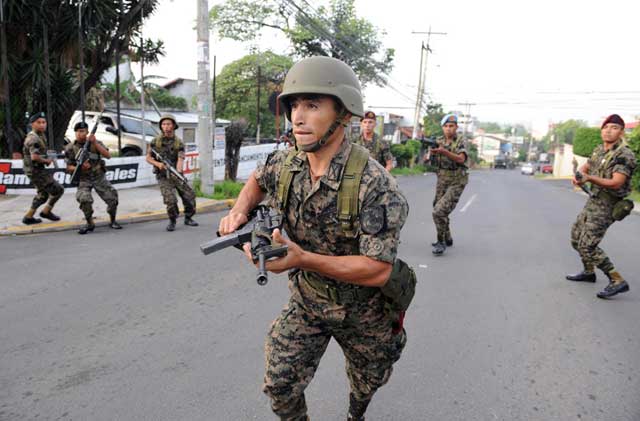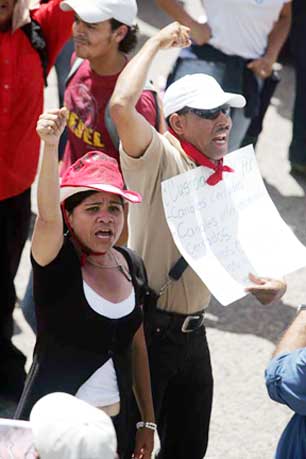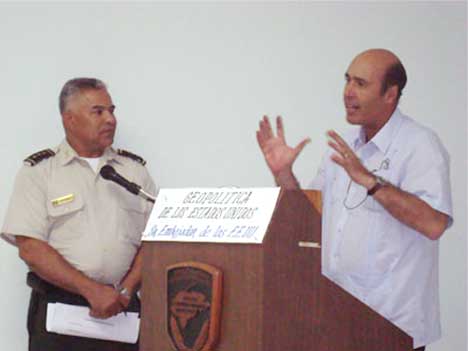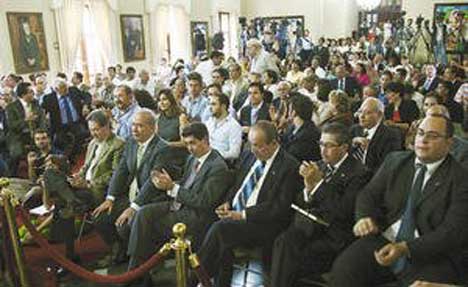

August 2009

Elite troops surround the home of Honduran president Manuel Zelaya on the morning of June 28.
(Photo: Orlando Sierra/AFP)
An abbreviated version of this article appeared in The Internationalist No. 29 (Summer 2009). This is a full translation of the Spanish-language article from the El Internacionalista supplement (August 2009).

Unionists march on Tocantín airport, where the police assassinated a youth, 4 July.
(Photo: Centros de Medios Independientes/Honduras)
AUGUST 6 – The ouster of President Manuel Zelaya Rosales by Honduran generals at the end of June sent shudders through Latin America. Leftists and trade-unionists bitterly recalled the dark days of the 1970s and 1980s, when much of the region was ruled by military juntas, thousands were murdered, tens of thousands fled into exile and those who remained were terrorized into submission.
Even “center-left” bourgeois governments such as in Argentina, Bolivia, Chile, Ecuador and elsewhere felt threatened, as they all have tenuous relations with their militaries. Below a thin veneer of “democracy,” the officers who carried out the “dirty wars” and ran the death squads are still there. The “moderates” looked to the new administration in Washington to solve the problem. Even Hugo Chávez in Venezuela appealed to the U.S.: “Obama, do something.” But more than a month later, the putschists are still in charge in Tegucigalpa, the death toll among the protesters is rising, and Zelaya is cooling his heels at the border.
We warned the day after the military takeover that those fighting against it should beware of U.S. intervention (rather than appeal for it), and demand “Yankee Imperialism, Hands Off!” (see “Honduras: Coup d’État in the Maquiladora Republic” in The Internationalist no. 29 [Summer 2009]). We called on workers to “fight against the coup while offering no political support whatsoever to the right-wing president.” In fact, Honduran unions have played a key role in resistance to the coup. But while protesters call for Zelaya’s return with full powers, the ousted president has agreed to terms that would make him a figurehead. Either way, the coup plotters would still be in place, ready to strike again.
What’s needed is not negotiations but a mobilization of the workers and peasants to sweep away the military gorilas and the capitalists and bourgeois politicians behind the coup, through revolutionary struggle for a workers and peasants government that would expropriate the oligarchs and the entire capitalist ruling class, as part of workers revolution throughout Central America, and beyond.
Today resistance is being organized through bodies such as the National Front Against the Coup d’ État (FNCGE, according to its initials in Spanish). This is a “popular front” formation which unites labor groups and leftists with the Democratic Unification Party, a minor bourgeois formation. Today tens of thousands of Hondurans are courageously protesting in the face of the guns of the military. But should opponents of the coup succeed in any degree in pushing back the coup plotters, this bourgeois opposition coalition will be a barrier blocking any struggle against the Honduran ruling class which spawned the coup. To overcome this roadblock to revolution it is necessary to begin organizing the nucleus of a revolutionary workers party that is politically independent of all capitalist politicians, parties and coalitions.
An old joke in Latin America goes, Question: Why has there never been a coup d’état in the United States? Answer: Because there is no American embassy in Washington. Of course, there was the 2000 judicial coup in which the Supreme Court, by a vote of 5 to 4, placed George Bush in the White House despite losing the popular vote.
Whether Republicans or Democrats are in power, U.S. imperialism is still the power behind the most reactionary forces in the hemisphere. Secretary of State Hillary Clinton clucked her tongue criticizing the putsch, but pointedly did not call it a coup d’état, as that would have required a cutoff of U.S. aid to the very forces that carried out the coup. She called on Costa Rican president Óscar Arias to “mediate.” This amounted to de facto recognition of the de facto “government” headed by the puppet Robert Micheletti. Clinton also sharply criticized Zelaya as “reckless” for attempting to go back to Honduras. So the military-backed regime is simply doing nothing, hoping to run the clock out until “elections” this fall.
We wrote in our first article that “the Honduran army doesn’t move a finger without the Pentagon and the CIA knowing about it,” and “at the very least, Washington is tolerating the coup.” Soon information began coming out that U.S. “diplomats” were up to their necks in the coup plotting. The New York Times (30 June) reported that:
“As the situation in Honduras worsened, Assistant Secretary of State Thomas A. Shannon Jr., along with Hugo Llorens, the American ambassador to Honduras, spoke with Mr. Zelaya, military officials and opposition leaders....
“‘There was talk of how they might remove the president from office, how he could be arrested, on whose authority they could do that,’ the administration official said. But the official said that the speculation had focused on legal maneuvers to remove the president, not a coup.”

The U.S. ambassador, Cuban gusano Hugo Llorens, lectures on U.S. geopolitics to the National Defense College of Honduras, two weeks before the coup. (Photo: Armed Forces of Honduras)
So Washington was discussing for weeks with the plotters about how to “remove” Zelaya, even “arrest” him ... and then the U.S. acts surprised when, after getting the okay from the Honduran Congress, the Honduran Supreme Court and the Archbishop of Tegucigalpa, the military goes ahead and ousts him! The U.S. just objected that the job was done so crudely.
Then, after the coup, and the wave of denunciations in Latin America, the Obama administration decides it has to do something, so it brings in Arias, an old pal of the Bushes (father and son) and an old hand at dousing conflagrations in Central America that threaten the stability of the empire. When the representatives of coup “president” Micheletti showed up in San José, they brought with them an “adviser,” one Bennet Ratcliff, a San Diego-based political consultant with ties to the Clintons. The New York Times (13 July) reported: “an official close to the talks said the team rarely made a move without consulting” Ratcliff. “‘Every proposal that Micheletti’s group presented was written or approved by the American,’ said another official close to the talks, referring to Mr. Ratcliff.”
In Washington, the Honduran Business Council hired lobbyist Lanny Davis to represent the coup “government,” arranging meetings with Republican Congressmen and testifying before Congress. Davis was Bill Clinton’s personal lawyer during the Monica Lewinsky affair. During last year’s primary elections, he was a surrogate for Hillary Clinton (whom he met at Yale, along with George W. Bush) making some of the harshest race-baiting attacks on Obama. (Davis is also a “senior advisor and spokesman” for The Israel Project, a Zionist PR operation. Israel, incidentally, is the only country to have recognized the coup “government” in Honduras.)
Meanwhile, the U.S. ambassador to Honduras, Hugo Llorens, is a Cuban gusano exile who was in charge of Andean affairs on the National Security Council at the time of the 2002 coup that briefly seized Hugo Chávez, in which the U.S. was heavily involved. As in that case and the 2004 ouster/kidnapping of Haitian president Jean-Bertrand Aristide by U.S. forces, the Honduran coup plotters produced a supposed “resignation letter” from Zelaya that was quickly revealed to be a phony. On top of this, various long-time Reagan/Bush operatives have been active in Honduras recently, including Otto Reich (another gusano) and John Negroponte (known as The Proconsul when he was U.S. ambassador in the 1980s), both heavily involved with Nicaraguan contras and Salvadoran death squads.
Various leftists have used the Clinton ties to argue that that was “Clinton’s Soft Coup” and an “attempt to torpedo Obama’s effort at détente in Latin America, including with Cuba” (Guillermo Almeyra in La Jornada, 2 August). All this shows is that illusions in Barack Obama are still strongly held in Latin America (and the U.S.). The Honduran coup plotters may have figured they could force the U.S. president’s hand. They are certainly identified with extreme right-wingers. Hillary Clinton may be particularly hostile to Zelaya and Chávez. But this is the Obama administration, not the Clinton administration, and the U.S. government as a whole, not just one putative faction, was preparing the ouster of Zelaya.
Frequently in Latin America, reformist leftists refer to the ruling class as an oligarchy, and label repressive regimes fascist. Often there is an implicit political program attached to these descriptions. If it is an oligarchy (rule by a select few), then the struggle against it should be for a democracy (rule of “the people”), they argue. Similarly, if a government is fascist, they seek to organize a popular front along with “democratic” bourgeois politicians and parties to combat it. The purpose is to constrain the struggle to a bourgeois-democratic framework. In contrast, we Trotskyists of the League for the Fourth International fight for a socialist revolution against capitalism.

Capitalists of Honduras hold an emergency meeting to ratify their support for coup leader Micheletti, 20 July. (Photo: Resistencia Honduras)
In contrast to some other, more advanced capitalist countries of Latin America, Honduras really does have an oligarchy, a very narrow ruling circle consisting of a few clans who tightly control the country’s economy and politics. Honduran sociologist Leticia Salomón identified key coup backers as media magnate Carlos Roberto Facussé (former president, palm oil monopolist, owner of La Tribuna), the Continental Group of Jaime Rosenthal and Gilberto Goldstein (owners of El Tiempo), and including the Ferrari, Canahuati, Atala, Lamas, Násser, Kattán, Lippman and Rafael Flores families, who between them control “90% of the country’s wealth” (Público [Spain], 30 July).
But that leaves aside the huge sectors of the economy, producing most of the exports, directly owned by the imperialists: Chiquita Brands and Dole Foods for bananas; U.S. and Canadian mining companies; Nike, Adidas and The Gap for maquiladora (free trade zone) clothing and shoe manufacturers. Their profits and exports have been hard-hit by the two national work stoppages, the constant highway occupations, the curfew and other side effects of the military seizure of power.
The generals who carried out the coup recently went on national television to explain how they were really “defending democracy.” One said of Zelaya’s government: “Central America was not the objective of this communism disguised as democracy.... This socialism, communism, chavismo, we could call it, was headed to the heart of the United States.” It seemed like a throwback to the rhetoric of the anti-Soviet Cold War, when Ronald Reagan warned of a “red tide” washing up from Central America. But the capitalists really did consider that Zelaya was toying with “communism.” After all, he raised the minimum wage by 60 percent. This caused great consternation in the board room of the imperialist fruit monopolies:
“Chiquita complained that the new regulations would cut into company profits, requiring the firm to spend more on costs than in Costa Rica: 20 cents more to produce a crate of pineapple and ten cents more to produce a crate of bananas to be exact.”
–Nikolas Kozloff, “Chiquita in Latin America,” Counterpunch, 17 July
The Honduran capitalist rulers are a clannish, insular, racist lot who have supported military dictatorship, except for the occasional “democratic” interlude, since they hardly have the social weight to dominate the country themselves. An example of their mentality came from one of the top officials of the coup regime, Enrique Ortez, who referred to Barack Obama as a “black boy” (negrito), which is the closest Spanish equivalent to the “n word.” Ortez’s remarks were so racist that the U.S. media glossed over them, and didn’t quote the whole statement. According to El Tiempo (7 July), Ortez said in an interview televised a week before the coup:
“I have negotiated with queers [maricones], prostitutes, with pinkos [ñángaras, an insulting Honduran term for leftists] , blacks, whites. ... I don’t have racial prejudices, I like the black boy from the hood [negrito del batey] who is presiding over the United States.”
And the day after being named “foreign minister” Ortez said on TV:
“The president of the republic [the U.S.], with all due respect to the black boy, doesn’t know where Tegucigalpa is.”
Eventually the coup plotters were forced to withdraw his appointment as head diplomat, and instead named him chief of staff for the dictator Micheletti. Finally, due to pressure from Washington they had to drop him altogether. But the fact that he could say that publicly shows the mindset of the Honduran capitalist ruling class, for whom such renarks are absolutely normal, reflecting their racist contempt toward the substantial black (and indigenous) population of Honduras.
The Honduran coup was not some local matter but an event of continental importance. It was clearly intended to send a message to the presidents of El Salvador, Mauricio Funes of the FMLN (Farabundo Martí National Liberation Front), and Nicaragua, Daniel Ortega of the FSLN (Sandinista National Liberation Front). These former leftist and guerrilla groups have become bourgeois parties carrying out “free-market” capitalist economic policies. Ortega, now a born-again Christian, even outlawed abortion under all circumstances. But that is not reactionary enough for the likes of the antediluvian Central American right. (In El Salvador, ARENA, the party of the death squads, ran a full-page newspaper ad calling to recognize the Honduran regime and telling Funes the same could happen to him.)
For the past month, Honduran trade unions, peasant and indigenous groups have been insistently mobilizing in the streets against the civilian-military dictatorship. The teachers unions have been one of the strongest points of resistance, shutting down schools for three weeks, then participating in two national work stoppages, and now back on indefinite strike following the cold-blooded assassination of two teachers, Roger Vallejo and Martin Riviera, the second stabbed 25 times as he left the wake for Vallejo. The brewing and bottling industry union (STIBYS), has also been prominent, with its union hall acting as an organizing center for protests. The union’s general secretary, Carlos Reyes, an independent candidate for president, was badly during the second national work stoppage.
So far the “civic work stoppages” have been largely limited to public sector workers, as the maquiladora operators keep their employees under tight control. A real general strike that shut down the maquiladoras, banana and mining sectors, cutting off Honduran exports would have a considerable impact. But that represents a whole different political orientation, organizing on a program of internationalist class struggle rather than on the bourgeois-democratic and nationalist basis that has dominated so far.
As we have noted, Honduras has a considerable history of leftist and labor agitation. It was in order to crush communist union organizing that the military took power in a previous coup, in 1963, when the liberal Democrat John F. Kennedy was in the White House. Many leftists are taking part in and leading protests. The FNCGD issues appeals to the world working class. Yet their program is to reinstall “Mel” Zelaya in the Presidential House. The demonstrations wave the Honduran flag and chant, “Mel amigo, el pueblo está contigo” (Mel, friend, the people are with you). Yet Zelaya is taking his marching orders from Washington, and if he does return it will be to bury any hopes that poor and working people may have had in his presidency. The referendum on holding a constituent assembly, a key issue that triggered the military takeover, is a dead letter.
Various would-be socialists and even self-proclaimed communists argue that it is necessary to subordinate everything to the fight to restore Zelaya’s presidency, even though he is no radical and certainly no representative of the impoverished working people. (He is a certified oligarch whose father, Manuel Zelaya Ordoñez, was a wealthy businessman who was convicted, and pardoned, for murdering 15 peasants, students and religious leaders and dumping their bodies in a well on his ranch in the 1975 Los Horcones massacre.)
This was not the program of the revolutionary Bolsheviks Lenin and Trotsky, who in the lead up to the 1917 October Revolution called to defeat a coup attempt by the tsarist general Kornilov, without defending the bourgeois government of Kerensky. As Lenin wrote,
“in these circumstances, a Bolshevik would say: ‘Our workers and soldiers will fight the counter-revolutionary troops if they start an offensive now against the Provisionial Government; they will do so not to defend the government . . . but to independently defend the revolution as they pursue their own aim, the aim of securing victory for the workers, for the poor, for the cause of peace, and not for the imperialists or for Kerensky”
–“Rumors of a Conspiracy,” August 1917
It was Stalin, the “great organizer of defeats,” who sacrificed the Spanish Revolution (and murdered the revolutionaries) on the altar of the Popular Front, massacring the Barcelona workers on the grounds that they threatened the bourgeois Republic. Yet it was the Spanish Republican government and its Stalinist-controlled police and army that prevented a victory over the reactionary militarist Franco, by blocking the workers and peasants from carrying through the revolution that had begun to expropriate the capitalists and landowners.
In Honduras today, revolutionary Marxists would mobilize to defeat the coup regime, but on a program of organizing workers revolution, not making political alliances with Zelaya and other bourgeois political forces. The important participation of the unions in the resistance should be used not to restore conditions to what they were on June 27, but to fight against all the capitalist politicians and their system that has condemned 75 percent of the population to a life of misery. Honduras has the lowest wages in Central America, with teachers earning US$130 a month and maquiladora workers US$140 a month (for 12-hour days). That is the main reason the clothing apparel and shoe manufacturers have come there in the first place.
Clearly such a fight takes preparation. It can begin in the course of the present battles, seeking to transform “civic” work stoppages into a nationwide strike by workers and their allies. It is crucial to extend the struggle to the workers in the maquiladora manufacturing plants, the fruit plantations and transport sectors. Working people in El Salvador, Guatemala, Nicaragua and Costa Rica should mobilize, including with strike action, to oppose the Honduran coup, which is a direct threat to them as well.
Workers outside Central America should seek to implement the call by the International Transport Workers Federation to refuse at this key moment to load or unload Honduran-flag ships, a ban which should be extended to any cargo from or to Honduras. Demonstrations in the United States, Mexico and elsewhere in Latin America should demand release of the hundreds of Hondurans being held in the dictatorship’s jails. Teachers unions should solidarize with their valiant sisters and brothers in Honduras who have risked all to defeat the gorilas. And we must continue to demand that the U.S. government get out of Honduras, that the Soto Cano military base at Palmerola be shut down, and that it cut off all aid to Honduras.
Mobilization against the capitalist coup must be on a class basis, forming councils of workers, peasants and the urban and rural poor, drawing in the oppressed black and indigenous populations. Such councils that can provide the basis for sweeping away the entire class of capitalist exploiters. Above all, what is needed is a struggle to forge the nucleus of a revolutionary workers party in Honduras and throughout Central America. Such a party can only be built on the program of permanent revolution, of Leon Trotsky’s Fourth International, namely that in the imperialist epoch even basic democratic demands including agrarian revolution, national liberal and democracy for the exploited and oppressed in semi-colonial countries like Honduras can only be achieved by the workers taking power, at the head of the peasantry and poor and led by their communist party, to establish their own class rule, and extend the revolution internationally. ■